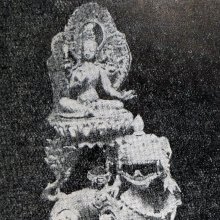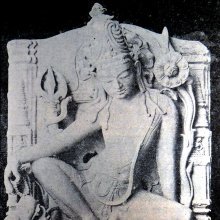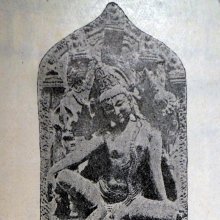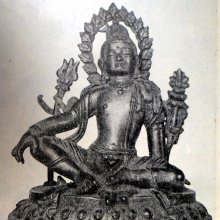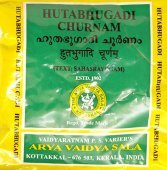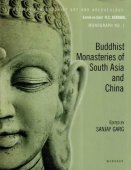Magadha, Māgadha, Māgadhā: 39 definitions
Introduction:
Magadha means something in Buddhism, Pali, Hinduism, Sanskrit, Jainism, Prakrit, the history of ancient India, Marathi. If you want to know the exact meaning, history, etymology or English translation of this term then check out the descriptions on this page. Add your comment or reference to a book if you want to contribute to this summary article.
Images (photo gallery)
In Hinduism
Natyashastra (theatrics and dramaturgy)
Source: Wisdom Library: Nāṭya-śāstra1) Māgadha (मागध) is the Sanskrit name of one of Bharata’s sons, mentioned in the Nāṭyaśāstra 1.26-33. After Brahmā created the Nāṭyaveda (nāṭyaśāstra), he ordered Bharata to teach the science to his (one hundred) sons. Bharata thus learned the Nāṭyaveda from Brahmā, and then made his sons study and learn its proper application. After their study, Bharata assigned his sons (eg., Māgadha) various roles suitable to them.
2) Māgadha (मागध) is the name of a tribe, usually to be represented by a dark or deep blue (śyāma) color when painting the limbs (aṅgaracanā), according to Nāṭyaśāstra chapter 23. The painting is a component of nepathya (costumes and make-up) and is to be done in accordance with the science of āhāryābhinaya (extraneous representation).

Natyashastra (नाट्यशास्त्र, nāṭyaśāstra) refers to both the ancient Indian tradition (shastra) of performing arts, (natya—theatrics, drama, dance, music), as well as the name of a Sanskrit work dealing with these subjects. It also teaches the rules for composing Dramatic plays (nataka), construction and performance of Theater, and Poetic works (kavya).
Vaishnavism (Vaishava dharma)
Source: ISKCON Press: GlossaryMagadha (मगध).—A province of ancient India; also the capital city of King Jarāsandha.

Vaishnava (वैष्णव, vaiṣṇava) or vaishnavism (vaiṣṇavism) represents a tradition of Hinduism worshipping Vishnu as the supreme Lord. Similar to the Shaktism and Shaivism traditions, Vaishnavism also developed as an individual movement, famous for its exposition of the dashavatara (‘ten avatars of Vishnu’).
Purana and Itihasa (epic history)
Source: archive.org: Puranic EncyclopediaMagadha (मगध).—A famous city of ancient India. Its present name is Rājagṛha. The Purāṇas mention many great Kings who had ruled Magadha. Bṛhadratha was once King of Magadha. (Śloka 30, Chapter 63, Ādi Parva) Jayatsena one of the Kālakeyas was once the King of Magadha. (Śloka 48, Chapter 67, Ādi Parva). Pāṇḍu father of the Pāṇḍavas once attacked Magadha and Dīrgha the then King of Magadha was killed by Pāṇḍu. (Chapter 112, Ādi Parva). While Bṛhadratha was ruling Magadha he passed an order that each and every house should worship the demoness Jarā as a house-goddess. (Śloka 10, Chapter 13, Sabhā Parva). During the time of the Mahābhārata Jarāsandha was the King of Magadha. Śrī Kṛṣṇa made Bhīmasena kill Jarāsandha. After his death Śrī Kṛṣṇa made Sahadeva brother of Jarāsandha the King of Magadha. (Śloka 43, Chapter 24, Sabhā Parva). Bhīmasena conquered this country during his victory march. The people of Magadha offered gifts to Yudhiṣṭhira at his Rājasūya. (Śloka 18, Chapter 52, Sabhā Parva). The King of Magadha and the people there fought on the side of the Pāṇḍavas in the great battle. (Śloka 2, Chapter 53, Udyoga Parva).
Source: archive.org: Nilamata Purana: a cultural and literary studyMāgadha (मागध) refers to a class of professional singers that once existed in ancient Kashmir (Kaśmīra) as mentioned in the Nīlamatapurāṇa.—The Nīlamata refers to four classes of professional singers viz. Sūta, Māgadha, Vandī and Cāraṇa who, according to the Dharmaśāstras, maintained themselves by lauding the deeds of others. Their mention in one and the same line indicates that some difference, may be minute, was believed to be existing in these different types of singers.
Source: Cologne Digital Sanskrit Dictionaries: The Purana Index1a) Magadha (मगध).—The kingdom of Jarāsandha (s.v.), see also Māgadha.*
- * Bhāgavata-purāṇa III. 3. 10; Brahmāṇḍa-purāṇa III. 39. 2, 8.
1b) —(c)—a Janapada; an eastern kingdom;1 got from Pṛthu by Māgadha; kingdom of the Māgadhas;2 kings of;3 sometimes ruled by the Nāgas;4 kingdom of Mahāratha Bṛhadratha;5 under the Guptas.6
- 1) Brahmāṇḍa-purāṇa II. 16. 55; 18. 51; Vāyu-purāṇa 45. 111. 47. 48; 62. 147; 99. 294; Viṣṇu-purāṇa II. 3. 16.
- 2) Brahmāṇḍa-purāṇa II. 36. 172; Matsya-purāṇa 50. 27.
- 3) Bhāgavata-purāṇa IX. 22. 44-5.
- 4) Brahmāṇḍa-purāṇa III. 74. 195.
- 5) Vāyu-purāṇa 99. 221.
- 6) Ib. 99. 383; Viṣṇu-purāṇa IV. 24. 63.
1c) King Viśvasphāṭika pulled down Kṣatriyas and established new varṇas; people of, like Kaivartas, Baṭu, Pulinda and Brahmanas.*
- * Viṣṇu-purāṇa IV. 24. 61.
2a) Māgadha (मागध).—Jarāsandha who was vanquished by Kṛṣṇa, see Magadha (s.v.).*
- * Bhāgavata-purāṇa III. 3. 10; X. 2. 2; 83. 23.
2b) Born of Pṛthu's sacrifice with Sūta; panegyrised Pṛthu and got Māgadha country as gift;1 at Kṛṣṇa's jātakarma;2 in the royal household.3
- 1) Bhāgavata-purāṇa IV. 15. 20; X. 5. 5; 50. 37; 53. 43; 70. 20; 71. 29; 84. 46; Brahmāṇḍa-purāṇa II. 36. 113, 159-160, 172; Vāyu-purāṇa 62. 95, 137; Viṣṇu-purāṇa I. 13. 52. 64.
- 2) Brahmāṇḍa-purāṇa III. 28. 1 and 4; 27. 13; 49. 21; 55. 9 and 14; IV. 26. 62
- 3) Matsya-purāṇa 212. 14; Vāyu-purāṇa 62. 147-148.
2c) (Paulastya)—a sage of the 14th epoch of Bhautya Manu.*
- * Bhāgavata-purāṇa VIII. 13. 34; Brahmāṇḍa-purāṇa IV. 1. 112; Vāyu-purāṇa 100. 116; Viṣṇu-purāṇa III. 2. 44.
2d) A Gandharva.*
- * Vāyu-purāṇa 69. 26.
2e) For Śrutaśravas, son of Somādhi.*
- * Vāyu-purāṇa 99. 228.
2f) The people of the Magadha country (eastern country Matsya-purāṇa); a Kingdom of Madhyadeśa;1 Kṣatriya caste of Śākadvīpa.2
- 1) Bhāgavata-purāṇa X. 2. 2; Brahmāṇḍa-purāṇa II. 16. 42; Matsya-purāṇa 114. 45; 121. 50; 163. 66.
- 2) Viṣṇu-purāṇa 11. 4. 69.
2g) The royal line from Bṛahadratha to Śrutaśravas.*
- * Matsya-purāṇa 50. 27-34.
Māgadha (मागध) is a name mentioned in the Mahābhārata (cf. I.61.46) and represents one of the many proper names used for people and places. Note: The Mahābhārata (mentioning Māgadha) is a Sanskrit epic poem consisting of 100,000 ślokas (metrical verses) and is over 2000 years old.
Source: Shodhganga: The saurapurana - a critical studyMagadha (मगध) refers to an ancient country which should be shunned, according to the 10th century Saurapurāṇa: one of the various Upapurāṇas depicting Śaivism.—It looks upon Kurukṣetra, Matsya, Pāñcāla and Surasena as holy countries where Dharma is practiced. It advises people to shun Aṅga, Vaṅga, Kaliṅga, Surāṣṭra, Gurjara, Ābhira, Kauṅkaṇa, Draviḍa, Dakṣiṇāpatha, Āndhra and Magadha.—(cf. verses 17.54-59) Thus it appears that this Purāṇa was written somewhere about the north-western part of northern India.

The Purana (पुराण, purāṇas) refers to Sanskrit literature preserving ancient India’s vast cultural history, including historical legends, religious ceremonies, various arts and sciences. The eighteen mahapuranas total over 400,000 shlokas (metrical couplets) and date to at least several centuries BCE.
Vastushastra (architecture)
Source: Wisdom Library: Vāstu-śāstraMāgadha (मागध) refers to a variety of prāsāda (upper storey of any building), according to the Śilparatna (32.3), the Mayamata (18.10) and the Kamikāgama (57.4).

Vastushastra (वास्तुशास्त्र, vāstuśāstra) refers to the ancient Indian science (shastra) of architecture (vastu), dealing with topics such architecture, sculpture, town-building, fort building and various other constructions. Vastu also deals with the philosophy of the architectural relation with the cosmic universe.
Shaktism (Shakta philosophy)
Source: Wisdom Library: ŚāktismMagadha (मगध) is the name of a Śāktapīṭha mentioned in the Kulārṇavatantra. The Kulārṇava-tantra is an important 11th century work for the Kaula school of Śāktism. It refers to eighteen such Śākta-pīṭhas (e.g. Magadha) which is defined as a sacred sanctuary of Devī located here on earth. According to legend, there are in total fifty-one such sanctuaries (pīṭha) on earth, created from the corresponding parts of Devī’s body,

Shakta (शाक्त, śākta) or Shaktism (śāktism) represents a tradition of Hinduism where the Goddess (Devi) is revered and worshipped. Shakta literature includes a range of scriptures, including various Agamas and Tantras, although its roots may be traced back to the Vedas.
Arthashastra (politics and welfare)
Source: Shodhganga: Kakati Ganapatideva and his times (artha)Magadha (मगध, “panegyrist”) is an official title designating one of the seventy-two officers (niyoga) of the Bāhattaraniyogādhipati circle, according to the Inscriptional glossary of Andhra Pradesh (Śāsana-śabdakośāmu). The bāhattaraniyoga-adhipati is the highest executive officer of this circle (including a Magadha). For example: During the reign of Gaṇapatideva, the area extending between Pānagal to Mārjavāḍi was entrusted to Gaṇḍapeṇḍāru Gangayasāhiṇi as Bāhattaraniyogādhipati. Later on, this office was entrusted to Kāyastha Jannigadeva.

Arthashastra (अर्थशास्त्र, arthaśāstra) literature concerns itself with the teachings (shastra) of economic prosperity (artha) statecraft, politics and military tactics. The term arthashastra refers to both the name of these scientific teachings, as well as the name of a Sanskrit work included in such literature. This book was written (3rd century BCE) by by Kautilya, who flourished in the 4th century BCE.
Kavya (poetry)
Source: Wisdom Library: KavyaMagadha refers to an ancient district or cultural territory, as mentioned in the 7th-century Mudrārākṣasa written by Viśākhadeva.
Source: archive.org: Aspects of Bengal society: Ship-building and commerceMagadha is the name of an ancient city mentioned by the author of the Kavikankan’s Chandikāvya pp. 195-202.—Accordingly, after the performance of the usual ceremonies before sailing, the merchant Dhanapati passed the following places: [...]—all by the side of the Ganges. Then he reached the very celebrated inland port of Bengal known as Saptagram near the Tribeni. The poet here incidentally praised this port and gave it a superiour place among the following ports and places: [e.g., Magadha, etc...]. According to the poet the merchants of the above places visit Saptagram but the merchants of Saptagram do never visit those ports and places.
Source: Shodhganga: The Kavyamimamsa of RajasekharaMagadha (मगध) is the name a locality mentioned in Rājaśekhara’s 10th-century Kāvyamīmāṃsā.—This is the province located in the Bihar or southern part of Bihar.

Kavya (काव्य, kavya) refers to Sanskrit poetry, a popular ancient Indian tradition of literature. There have been many Sanskrit poets over the ages, hailing from ancient India and beyond. This topic includes mahakavya, or ‘epic poetry’ and natya, or ‘dramatic poetry’.
Jyotisha (astronomy and astrology)
Source: Wisdom Library: Brihat Samhita by VarahamihiraMagadha (मगध) refers to a country belonging to “Pūrvā or Pūrvadeśa (eastern division)” classified under the constellations of Ārdrā, Punarvasu and Puṣya, according to the system of Kūrmavibhāga, according to the Bṛhatsaṃhitā (chapter 14), an encyclopedic Sanskrit work written by Varāhamihira mainly focusing on the science of ancient Indian astronomy astronomy (Jyotiṣa).—Accordingly, “The countries of the Earth beginning from the centre of Bhāratavarṣa and going round the east, south-east, south, etc., are divided into 9 divisions corresponding to the 27 lunar asterisms at the rate of 3 for each division and beginning from Kṛttikā. The constellations of Ārdrā, Punarvasu and Puṣya represent the eastern division consisting of [i.e., Magadha] [...]”.

Jyotisha (ज्योतिष, jyotiṣa or jyotish) refers to ‘astronomy’ or “Vedic astrology” and represents the fifth of the six Vedangas (additional sciences to be studied along with the Vedas). Jyotisha concerns itself with the study and prediction of the movements of celestial bodies, in order to calculate the auspicious time for rituals and ceremonies.
General definition (in Hinduism)
Source: archive.org: Indian Historical Quarterly Vol. 7Magadha (मगध) is the name of a country classified as both Hādi and Kādi (both types of Tantrik division), according to the 13th century Sammoha-tantra (fol. 7).—There are ample evidences to prove that the zone of heterodox Tantras went far beyond the natural limits of India. [...] The zones in the Sammoha-tantra [viz., Magadha] are here fixed according to two different Tantrik modes, known as Kādi and Hādi.
In Buddhism
Theravada (major branch of Buddhism)
Source: Pali Kanon: Pali Proper NamesOne of the four chief kingdoms of India at the time of the Buddha, the others being Kosala, the kingdom of the Vamsas and Avanti. Magadha formed one of the sixteen Mahajanapadas and had its capital at Rajagaha or Giribbaja where Bimbisara, and after him Ajatasattu, reigned. Later, Pataliputta became the capital. By the time of Bimbisara, Anga, too, formed a part of Magadha, and he was known as king of Anga Magadha (see, e.g., Vin.i.27 and ThagA.i.544, where Bimbisara sends for Sona Kolivisa, a prominent citizen of Campa, capital of Anga). But prior to that, these were two separate kingdoms, often at war with each other (e.g., J.iv.454f). Several kings of Magadha are mentioned by name in the Jatakas - e.g., Arindama and Duyyodhana. In one story (J.vi.272) the Magadha kingdom is said to have been under the suzerainty of Anga. In the Buddhas day, Magadha (inclusive of Anga) consisted of eighty thousand villages (Vin.i.179) and had a circumference of some three hundred leagues (DA.i.148).
Ajatasattu succeeded in annexing Kosala with the help of the Licchavis, and he succeeded also in bringing the confederation of the latter under his sway; preliminaries to this struggle are mentioned in the books (e.g., D.ii.73f., 86).
Under Bimbisara and Ajatasattu, Magadha rose to such political eminence that for several centuries, right down to the time of Asoka, the history of Northern India was practically the history of Magadha. (A list of the kings from Bimbisara to Asoka is found in Dvy.369 ; cp. DA.i.153; Mbv.96, 98).
At the time of the Buddha, the kingdom of Magadha was bounded on the east by the river Campa (Campa flowed between Anga and Magadha; J.iv.454), on the south by the Vindhya Mountains, on the west by the river Sona, and on the north by the Ganges. The latter river formed the boundary between Magadha and the republican country of the Licchavis, and both the Magadhas and the Licchavis evidently had equal rights over the river. When the Buddha visited Vesali, Bimbisara made a road five leagues long, from Rajagaha to the river, and decorated it, and the Licchavis did the same on the other side. DhA.iii.439 f.; the Dvy. (1p.55) says that monks going from Savatthi to Rajagaha could cross the Ganges in boats kept either by Ajatasattu or by the Licchavis of Vesali.
During the early Buddhist period Magadha was an important political and commercial centre, and was visited by people from all parts of Northern India in search of commerce and of learning. The kings of Magadha maintained friendly relations with their neighbours, Bimbisara and Pasenadi marrying each others sisters. Mention is made of an alliance between Pukkusati, king of Gandhara and Bimbisara. When Candappajjota of Ujjeni was suffering from jaundice, Bimbisara sent him his own personal physician, Jivaka.
-- or --
. The name of a gotta. J.iii.339.
-- or --
. Theravāda is a major branch of Buddhism having the the Pali canon (tipitaka) as their canonical literature, which includes the vinaya-pitaka (monastic rules), the sutta-pitaka (Buddhist sermons) and the abhidhamma-pitaka (philosophy and psychology).
Mahayana (major branch of Buddhism)
Source: archive.org: Bulletin of the French School of the Far East (volume 5)Magadha (मगध) (in Chinese: kia-p'i-lo-p'o) refers to one of the fifty-five kingdoms enumerated in chapter 17 of the Candragarbha: the 55th section of the Mahāsaṃnipāta-sūtra, a large compilation of Sūtras (texts) in Mahāyāna Buddhism partly available in Sanskrit, Tibetan and Chinese.—In the Candragarbhasūtra, the Bhagavat invites all classes of Gods and Deities to protect the Law [dharma?] and the faithful in their respective districts.—In Magadha, the following deities are appointed (among others): The Devaputra Susthitijvālāprabha [?]; the Gandharva Utpala; the Asura Joie-son (Nandighoṣa?); the Nāgarāja Subāhu [?] and Sumanas [?]; the Asura Mayūragandha [?]; the Mahāyakṣa Kunāla; the Yakṣa Kumbhīra; the Kumbhāṇḍa Daśagaja [?]; the Goddess Manoharī [?].
Magadha (मगध) (in Chinese: Mo-kia-t'o) is the name of an ancient kingdom associated with Rohiṇī or Rohiṇīnakṣatra, as mentioned in chapter 18.

Mahayana (महायान, mahāyāna) is a major branch of Buddhism focusing on the path of a Bodhisattva (spiritual aspirants/ enlightened beings). Extant literature is vast and primarely composed in the Sanskrit language. There are many sūtras of which some of the earliest are the various Prajñāpāramitā sūtras.
General definition (in Buddhism)
Source: Buddhist Door: GlossaryOne of the four great kingdoms (i.e. Magadha, Kosala, Vansa, and Avanti) in ancient India. The capital of Magadha was Rajagaha. The king of Magadha, Bimblisara, became the follower of Shakyamuni.In Jainism
General definition (in Jainism)
Source: archive.org: Trisastisalakapurusacaritra1) Magadha (मगध) (distinguished by the city Rājagṛha) refers to one of the 25½ countries of the Kṣetrāryas, situated in the “middle world” (madhyaloka), according to chapter 2.3 [ajitanātha-caritra] of Hemacandra’s 11th century Triṣaṣṭiśalākāpuruṣacaritra: an ancient Sanskrit epic poem narrating the history and legends of sixty-three illustrious persons in Jainism.
Accordingly:—“In these 35 zones on this side of Mānuṣottara and in the Antaradvīpas, men arise by birth; [...]. From the division into Āryas and Mlecchas they are two-fold. The Āryas have sub-divisions [e.g., kṣetra (country)]. [...] The kṣetrāryas are born in the 15 Karmabhumis. Here in Bharata they have 25½ places of origin (e.g., Magadha), distinguishable by cities (e.g., Rājagṛha) in which the birth of Tīrthakṛts, Cakrabhṛts, Kṛṣṇas, and Balas takes place”.
2) Māgadha (मागध) is the name of a mixed caste (offspring of a Kṣatriya-woman and Vaiśya-man), according to chapter 2.6.—Accordingly, as chief-minister Subuddhi said to king Sagara said: “[...] Once upon a time there lived a king in a certain city in Bharatakṣetra in this same Jambūdvīpa. [...] One day, the door-keeper announced: ‘Some man at the door, holding a wreath in his hand, who appears to know the arts, wishes to see Your Majesty in order to tell something now. [...]’. The king spoke graciously to him: ‘Sir, from what caste are you, Brāhman, Kṣatriya, Vaiśya, or Śudra? Or are you from the mixed castes, Ambaṣṭha, Māgadha, etc.? Or do you know the Vedas, or the Purāṇas, or the Smṛtis? Or are you an astrologer, or are you expert in the triple science? [...]’”.
Source: HereNow4u: Lord Śrī MahāvīraMagadha (मगध) is the name of a country visited by Mahāvīra during his seventh year of spiritual-exertion.—At the end of the rainy season, the Lord broke his fast outside the Bhadrikā city and left for Magadha. Wandering across different parts of Magadha, the Lord practised the seventh year of austerity without calamities for eight months. He reached the Ālambhiyā city for the monsoon stay and observing four months fast, completed his cāturmāsa meditation breaking his fast outside the city he stayed in the Vasudeva temple in ‘Kaṇḍāga’ and in Baladeva temple ‘Bhaddaṇā’ he reached Bahusāla village and there in a Sāla forest, he became meditative.
Magadha was also visited by Mahāvīra during his 10th year as Kevalī.

Jainism is an Indian religion of Dharma whose doctrine revolves around harmlessness (ahimsa) towards every living being. The two major branches (Digambara and Svetambara) of Jainism stimulate self-control (or, shramana, ‘self-reliance’) and spiritual development through a path of peace for the soul to progess to the ultimate goal.
India history and geography
Source: archive.org: The ocean of story (history)Magadha (मगध).—This ancient kingdom corresponds to the modern districts of Patna, Gayā and Ṣāhābād in South Bihār. Its great importance in Indian history will be realised when we remember that it was not only the home of Buddhism and Jainism, but also the nucleus of two of the greatest of the Indian empires, the Maurya and the Gupta. Until the sixth century b.c. its capital was Girivraja, when its place was taken by Rājagṛha, the modern Rājgīr. Further information will be found in Rhys Davids’ Buddhist India, 1905; Cunningham’s Ancient Geography of India, 1871; and the Cambridge History of India, vol. i, 1922. —n.m.p.
Source: Ancient Buddhist Texts: Geography of Early BuddhismMagadha is one of the sixteen Mahājanapadas of the Majjhimadesa (Middle Country) of ancient India, as recorded in the Pāli Buddhist texts (detailing the geography of ancient India as it was known in to Early Buddhism).—Early Pāli literature abounds in information about the Magadha country, its people, and its ancient capital Giribbaja. Magadha roughly corresponds to the modern Patna and Gayā districts of Bihar. Its earliest capital was Girivraja, or old Rājagriha, near Rājgir among the hills near Gayā. The Mahāvagga calls it Giribbaja of the Magadhas in order to distinguish it from other cities of the same name (Cf. Girivraja in Kekaya).
The Vinaya Piṭaka tells us that Magadha comprised eighty thousand villages all of which were under the sway of King Bimbisāra. The same work informs us that the river Tapodā flowed by this ancient city. Magadha was an important centre of Buddhism. According to the Kathāvatthu account Sāriputta and Moggallāna were converted by the Buddha to his faith while the latter was in Magadha. The Samantapāsādikā tells us that the missionaries who visited various places to preach the dhamma of Asoka were almost all natives of Magadha. In Asoka’s time the capital of the Magadhan kingdom was Pāṭaliputta (the older Pāṭaligāma where the ministers of Ajātasattu built a fort to repel the Vajjis). Pāli literature, however, contains numerous references to Rājagaha, the ancient capital of Magadha.
Source: OpenEdition books: Vividhatīrthakalpaḥ (History)Magadhā (मगधा) is the name of a Tīrtha (i.e., non-Jaina holy places), associated with Vaibhāra, as is mentioned in the Vividhatīrthakalpa by Jinaprabhasūri (13th century A.D.): an ancient text devoted to various Jaina holy places (tīrthas).
Source: Singhi Jain Series: Ratnaprabha-suri’s Kuvalayamala-katha (history)Magadha (मगध) is classified as one of the eighteen dialects (Deśī) of ancient India, as described in the Kathās (narrative poems) such as Uddyotanasūri in his 8th-century Kuvalayamālā (a Prakrit Campū, similar to Kāvya poetry).—Page 152.24 ff.: Here we have a specimen of eighteen Deśī dialects spoken in: [e.g., Magadha] [...] These different idioms of speech were spoken by the shop-keepers in the market place of Vijayāpurī. [...]

The history of India traces the identification of countries, villages, towns and other regions of India, as well as mythology, zoology, royal dynasties, rulers, tribes, local festivities and traditions and regional languages. Ancient India enjoyed religious freedom and encourages the path of Dharma, a concept common to Buddhism, Hinduism, and Jainism.
Languages of India and abroad
Pali-English dictionary
Source: BuddhaSasana: Concise Pali-English Dictionarymagadha : (m.) the country of Magadha, which includes present Bihar and Orissa. || māgadha (adj.) belonging to Magadha.
Source: Sutta: The Pali Text Society's Pali-English DictionaryMāgadha, (fr. Magadha) scent-seller, (lit. “from Magadha”) Pv. II, 937 (=gandhin PvA. 127). (Page 527)

Pali is the language of the Tipiṭaka, which is the sacred canon of Theravāda Buddhism and contains much of the Buddha’s speech. Closeley related to Sanskrit, both languages are used interchangeably between religions.
Marathi-English dictionary
Source: DDSA: The Molesworth Marathi and English Dictionarymāgadha (मागध).—m S A bard or minstrel.
Source: DDSA: The Aryabhusan school dictionary, Marathi-Englishmāgadha (मागध).—m A bard or minstrel.
Marathi is an Indo-European language having over 70 million native speakers people in (predominantly) Maharashtra India. Marathi, like many other Indo-Aryan languages, evolved from early forms of Prakrit, which itself is a subset of Sanskrit, one of the most ancient languages of the world.
Sanskrit dictionary
Source: DDSA: The practical Sanskrit-English dictionaryMagadha (मगध).—1 Name of a country, the southern part of Bihar; अस्ति मगधेषु पुष्पपुरी नाम नगरी (asti magadheṣu puṣpapurī nāma nagarī) Daśakumāracarita 1; अगाधसत्त्वो मगधप्रतिष्ठः (agādhasattvo magadhapratiṣṭhaḥ) R.6.21.
2) A bard, minstrel.
-dhāḥ (pl.) The people of Magadha, the Magadhas.
-dhā 1 The town of the Magadhas.
2) Long pepper.
Derivable forms: magadhaḥ (मगधः).
--- OR ---
Māgadha (मागध).—a. (-dhī f.) [मगधदेशे भवः अण् (magadhadeśe bhavaḥ aṇ)] Relating to or living in the country of Magadha or the people of Magadha.
-dhaḥ 1 A king of the Magadhas.
2) Name of a mixed tribe, said to have been the offspring of a Vaiśya father and a Kṣatriya mother, (the duty of the members of this caste being that of professional bards); Manusmṛti 1.11,17; क्षत्रिया मागधं वैश्यात् (kṣatriyā māgadhaṃ vaiśyāt) Y.1.94; Mahābhārata (Bombay) 13.49.1.
3) A bard or panegyrist in general; सूतमागधबन्दिनः (sūtamāgadhabandinaḥ) Bhāgavata 1.11.2; परिणतिमिति रात्रेर्मागधा माधवाय (pariṇatimiti rātrermāgadhā mādhavāya) Śiśupālavadha 11.1.
-dhāḥ (pl.) Name of a people, the Magadhas.
-dhā 1 A princess of the Magadhas.
2) Long pepper.
-dhī 1 A princess of the Magadhas; तयोर्जगृहतुः पादान् राजा राज्ञी च मागधी (tayorjagṛhatuḥ pādān rājā rājñī ca māgadhī) R.1.57.
2) The language of the Magadhas, one of the four principal kinds of Prākṛta.
3) Long pepper.
4) White cumin.
5) Refined sugar.
6) A kind of jasmine.
7) A variety of cardamoms.
8) The daughter of a Kṣatriya mother and a Vaiśya father.
9) Anise.
1) Name of a river (śoṇā).
11) A kind of रीति (rīti) in rhetorics. The अलङ्कारशेखर (alaṅkāraśekhara) (7) gives the following illustration:पाणौ पद्मधिया मधूक- कुसुमभ्रान्त्या पुनर्गण्डयोर्नीलेन्दीवरशङ्कया नयनयोर्बन्धूकबुद्ध्याधरे । लीयन्ते कबरीषु बान्धवजनव्यामोहजातस्पृहा दुर्वारा मधुपाः कियन्ति तरुणि स्थानानि रक्षिष्यसि (pāṇau padmadhiyā madhūka- kusumabhrāntyā punargaṇḍayornīlendīvaraśaṅkayā nayanayorbandhūkabuddhyādhare | līyante kabarīṣu bāndhavajanavyāmohajātaspṛhā durvārā madhupāḥ kiyanti taruṇi sthānāni rakṣiṣyasi) ||
--- OR ---
Māgadhā (मागधा).—Long pepper.
See also (synonyms): māgadhikā.
Source: Cologne Digital Sanskrit Dictionaries: Edgerton Buddhist Hybrid Sanskrit DictionaryMāgadha (मागध).—name of a yakṣa: Mahā-Māyūrī 63.
Source: Cologne Digital Sanskrit Dictionaries: Shabda-Sagara Sanskrit-English DictionaryMagadha (मगध).—m.
(-dhaḥ) 1. A country, South Behar. 2. An inhabitant of that country. 3. A bard, whose peculiar province is to sing the praises of a chief’s ancestry in his presence, a family bard or minstrel. f.
(-dhā) 1. Long pepper. 2. The town of the Magadhas. E. magadha a Kandwadi verb, to ask, aff. ac; or magadha the country, aṇ aff., with alteration of the vowel optional; hence also māgadha .
--- OR ---
Māgadha (मागध).—mfn.
(-dhaḥ-dhī-dhaṃ) Belonging to, or produced in the province of Magad'ha or south Behar. m.
(-dhaḥ) 1. A bard, a minstrel, whose duty it is, to recite the praises of sovereigns, their genealogy, and the deeds of their ancestors, in their presence; and to attend oni the march of an army, and animate the soldiers by martial songs: the minstrel forms a particular caste, said to spring from a Vaisya father, and Kshetriya mother; in mythology, they are said to have been created at once by the will of Siva; under the name of Bhauts, they are still numerous in the west of Inda where they are a privileged tribe. 2. Cumin-seed. m. Plu.
(-dhāḥ) The inhabitants or people of Magadha. f. (-dhī) 1. A kind of jasmine. (Jasminum auriculatum.) 2. Long-pepper, (Piper longum.) 3. A sort of cardamoms grown in Guzerat. 4. Refined sugar. 5. A dialect of Sanskrit: one of the principal forms of Prakrita, and nearly the same as that used in the sacred books of the Baudd'has and Jain'as: in the drama it is the dialect of the attendants and companions of royal personages. E. magadha a Kandwadi verb, to ask, (reward,) aff. aṇ; or magadha the country, and aṇ derivative aff.
Source: Cologne Digital Sanskrit Dictionaries: Benfey Sanskrit-English DictionaryMagadha (मगध).—I. m. 1. The name of a country, [Hitopadeśa] 36, 10, M. M. 2. An inhabitant of that country. 3. A bard. Ii. f. dhā, Long pepper.
--- OR ---
Māgadha (मागध).—i. e. magadha + a, I. adj. Belonging to, or produced in, Magadha, [Raghuvaṃśa, (ed. Stenzler.)] 1, 57. Ii. m. 1. pl. The inhabitants of Magadha. 2. A bard, [Johnson's Selections from the Mahābhārata.] 37, 16. 3. The son of a Vaiśya by a Kṣatriya woman, [Mānavadharmaśāstra] 10. 11. 4. Cumin-seed. Iii. f. dhī. 1. One of the Prakṛta dialects. 2. A kind of jasmine, Jasminum auriculatum. 3. Long pepper. 4. A sort of cardamoms. 5. Refined sugar.
Source: Cologne Digital Sanskrit Dictionaries: Cappeller Sanskrit-English DictionaryMagadha (मगध).—[masculine] [plural] [Name] of a country and people.
--- OR ---
Māgadha (मागध).—[feminine] ī relating to, coming from, or born among the Magadhas.
— [masculine] a prince of the Magadhas, [plural] [Name] of a people ( = magadha) & a caste; [feminine] ā a princess of the [Middle], [feminine] ī the same or the language of the Magadhas.
Source: Cologne Digital Sanskrit Dictionaries: Monier-Williams Sanskrit-English Dictionary1) Magadha (मगध):—m. the country of the Magadhas, South Behār ([plural] the people of that country), [Atharva-veda] etc. etc.
2) a minstrel who sings the praises of a chief’s ancestry, [cf. Lexicographers, esp. such as amarasiṃha, halāyudha, hemacandra, etc.]
3) Magadhā (मगधा):—[from magadha] f. the town of the M°s [cf. Lexicographers, esp. such as amarasiṃha, halāyudha, hemacandra, etc.]
4) [v.s. ...] long pepper, [Suśruta]
5) Māgadha (मागध):—mf(ī)n. relating to or born in or living in or customary among the Magadhas or the Magadha country, [Atharva-veda.Pariś.; Lalita-vistara] etc.
6) m. a king of the M°, [Mahābhārata; Harivaṃśa]
7) Name of a mixed caste, [Atharva-veda] etc. etc. (accord to, [Manu-smṛti x, 11] the son of a Kṣatriya mother and a Vaiśya father; he is the professional bard or panegyrist of a king, often associated with sūta and bandin, [Mahābhārata; Kāvya literature] etc.; [according to] to others one who informs a Rāja of what occurs in bazaars; also an unmarried woman’s son who lives by running messages or who cleans wells or dirty clothes etc.; also opprobrious Name of a tribe still numerous in Gujarat, and called the Bhāts, [Horace H. Wilson])
8) white cumin, [cf. Lexicographers, esp. such as amarasiṃha, halāyudha, hemacandra, etc.]
9) Name of one of the seven sages in the 14th Manv-antara, [Harivaṃśa]
10) of a son of Yadu, [ib.]
11) ([plural]) Name of a people (= magadhāḥ), [Atharva-veda.Pariś.; Mahābhārata] etc.
12) of the warrior-caste in Śāka-dvīpa, [Viṣṇu-purāṇa]
13) of a dynasty, [ib.]
14) Māgadhā (मागधा):—[from māgadha] f. a princess of the Magadhas, [Padma-purāṇa]
15) [v.s. ...] long pepper, [cf. Lexicographers, esp. such as amarasiṃha, halāyudha, hemacandra, etc.]
Source: Cologne Digital Sanskrit Dictionaries: Yates Sanskrit-English Dictionary1) Magadha (मगध):—(dhaḥ) 1. m. A country south Behar; an inhabitant of it; a family bard. f. (dhā) Long-pepper.
2) Māgadha (मागध):—(dhaḥ) 1. m. A bard; a minstrel; cumin seed; plu. inhabitants of south Behār. f. (dhī) A dialect; jasmin. a. Belonging to Behār.
Source: DDSA: Paia-sadda-mahannavo; a comprehensive Prakrit Hindi dictionary (S)Magadha (मगध) in the Sanskrit language is related to the Prakrit words: Magaha, Magahaga.
[Sanskrit to German]
Sanskrit, also spelled संस्कृतम् (saṃskṛtam), is an ancient language of India commonly seen as the grandmother of the Indo-European language family (even English!). Closely allied with Prakrit and Pali, Sanskrit is more exhaustive in both grammar and terms and has the most extensive collection of literature in the world, greatly surpassing its sister-languages Greek and Latin.
Kannada-English dictionary
Source: Alar: Kannada-English corpusMagadha (ಮಗಧ):—
1) [noun] a minstrel who sings the praises of a king and his ancestry.
2) [noun] name of a country corresponding to the current southern Bihar state.
--- OR ---
Māgadha (ಮಾಗಧ):—
1) [noun] the plant Chrysanthemum indicum ( = Pyrethrum indicum) of Asteraceae family.
2) [noun] its flower.
--- OR ---
Māgadha (ಮಾಗಧ):—[adjective] of or belonging to the country ಮಗಧ [magadha].
--- OR ---
Māgadha (ಮಾಗಧ):—
1) [noun] any king of the ancient country ಮಗಧ, [magadha,] the southern region of present Bihar state.
2) [noun] a bard who would sing in praise of his king.
3) [noun] (masc.) an offspring of a such a bard and a woman of kṣatriya (military caste).
Kannada is a Dravidian language (as opposed to the Indo-European language family) mainly spoken in the southwestern region of India.
See also (Relevant definitions)
Starts with (+15): Magadhadesha, Magadhadeshiya, Magadhagovinda, Magadhajadi, Magadhajira, Magadhaka, Magadhakhetta, Magadhalipi, Magadhamadhava, Magadhamana, Magadhanarkuti, Magadhaparibhasha, Magadhapratishtha, Magadhapura, Magadhapuri, Magadhas, Magadhatirtha, Magadhatirthakumara, Magadhavamshaja, Magadhesha.
Ends with: Madhavamagadha, Odramagadha, Purvamagadha, Samagadha, Sumagadha.
Full-text (+464): Rajagriha, Magadhaka, Magadheshvara, Girivraja, Magadhadeshiya, Magadhiya, Pataliputra, Sumagadha, Magadhadesha, Magadhika, Rishigiri, Magadhapura, Purvamagadha, Vishvasphatika, Shrenika, Palashakhanda, Jarasandha, Sumagadham, Magadhapuri, Magadhodbhava.
Relevant text
Search found 158 books and stories containing Magadha, Māgadha, Māgadhā, Magadhā; (plurals include: Magadhas, Māgadhas, Māgadhās, Magadhās). You can also click to the full overview containing English textual excerpts. Below are direct links for the most relevant articles:
Garga Samhita (English) (by Danavir Goswami)
Verses 6.1.48-51 < [Chapter 1 - Jarāsandha’s Defeat]
Verse 1.12.36 < [Chapter 12 - Description of Śrī Nanda’s Festival]
Verse 6.1.8 < [Chapter 1 - Jarāsandha’s Defeat]
The Bhagavata Purana (by G. V. Tagare)
Chapter 50(a) - Jarāsandha’s Second Expedition < [Book 10 - Tenth Skandha]
Chapter 50(b) - The Third Siege of Mathura: Jarāsandha’s defeat < [Book 10 - Tenth Skandha]
Chapter 5 - Celebration of Kṛṣṇa’s Birth: Meeting of Nanda and Vasudeva < [Book 10 - Tenth Skandha]
Manusmriti with the Commentary of Medhatithi (by Ganganatha Jha)
Verse 10.26 < [Section II - Mixed Castes]
Verse 10.6 < [Section II - Mixed Castes]
Verse 10.31 < [Section II - Mixed Castes]
Amarakoshodghatana of Kshirasvamin (study) (by A. Yamuna Devi)
Professions, Servants and Employed persons < [Chapter 3 - Social Aspects]
Miscellaneous (1): Geographical Data < [Chapter 3 - Social Aspects]
Cāturvarṇya System < [Chapter 3 - Social Aspects]
Trishashti Shalaka Purusha Caritra (by Helen M. Johnson)
Part 14: Expedition of conquest < [Chapter IV - Anantanāthacaritra]
Part 18: Expedition of conquest < [Chapter II - Vāsupūjyacaritra]
Part 23: Conquest of southern half of Bharata by Tripṛṣṭha < [Chapter I - Śreyāṃsanāthacaritra]
The Matsya Purana (critical study) (by Kushal Kalita)
Part 2.2 - Dynasties of Post-Mahābhārata war (Introduction) < [Chapter 3 - Historical aspects in the Matsyapurāṇa]
Part 2.1 - Dynasties of Pre-Mahābhārata war (Introduction) < [Chapter 3 - Historical aspects in the Matsyapurāṇa]
Part 2.2a - The Magadha Dynasty < [Chapter 3 - Historical aspects in the Matsyapurāṇa]
Related products
